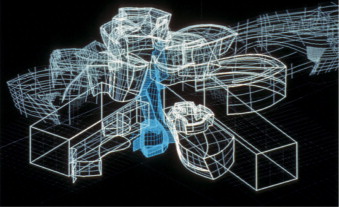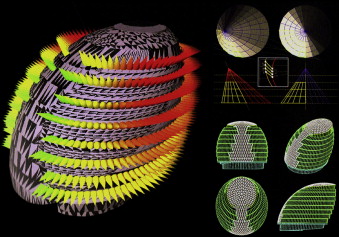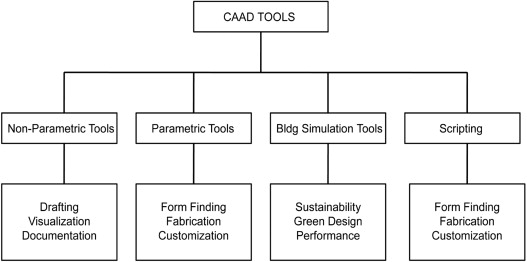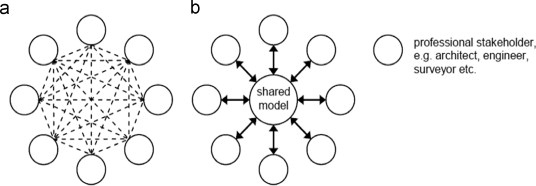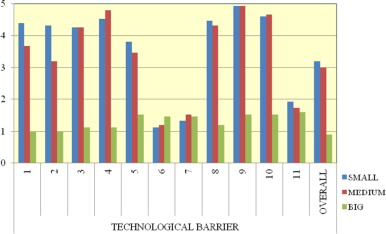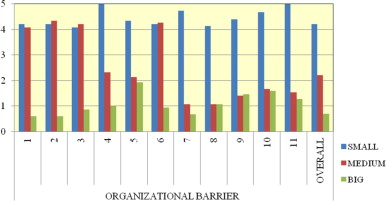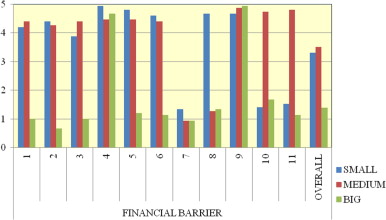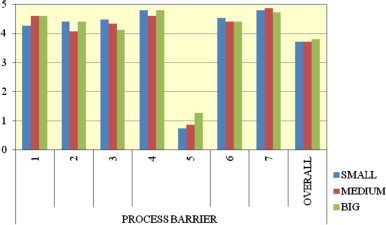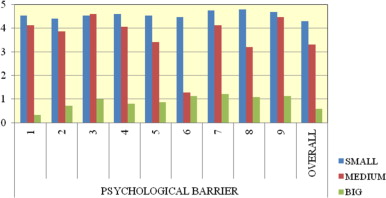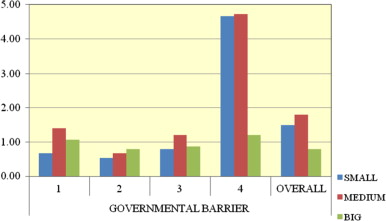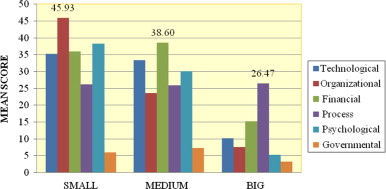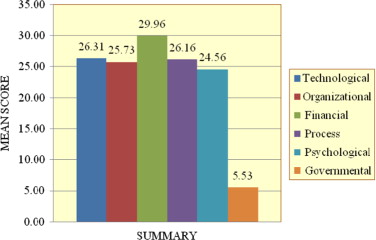Abstract
The development and use of design technology for architecture in the modern world have led to the emergence of various design methodologies. Current design research has focused on a computationally mediated design process. This method is essentially concerned with finding forms and building performance simulation, i.e., structural, environmental, constructional, and cost performance, by integrating physics and algorithms. From the emergence of this process, design practices have been increasingly aided by and dependent on the technology, which has resulted in a major paradigm shift. Advancement of the new technology has the potential to improve design and productivity dramatically. However, related literature shows that substantial technical and organizational barriers exist. These barriers inhibit the effective adoption of these technologies. The effect of these obstacles on architectural practice varies depending on the size of an architectural organization. To further understand the problem, we conducted an in-depth study on several small, medium, and large architectural organizations. This study involves in-depth evaluation of technological, financial, organizational, governmental, psychological, and process barriers encountered in the adoption of digital innovation. Results reveal relevant attributes and patterns of variables, which can be used to establish a framework for digital innovation adoption. Valuable findings of this study reveal that smaller architectural organizations present more barriers to digital innovation compared with their larger counterparts. This study is important because it contributes to the research on digital innovation in architecture and addresses the barriers faced by different sizes of architectural organizations.
Keywords
Digital innovation ; Architectural organizations ; Technologies ; Digital innovation barriers
1. Introduction
Technological advancement of the new technology has the potential to improve design and productivity dramatically. However, related literature shows that substantial technical and organizational barriers exist, which inhibit the effective adoption of these technologies (Leach and Guo, 2007 ; Johnson and Laepple, 2004 ; Inchachoto, 2002 ). Despite the availability of digital technologies, innovation does not occur because limited knowledge and resources are transferred from one project to another. This concern occurs when projects have dissimilar objectives or exclude members of the previous team with relevant skills or knowledge. Cory and Bozell (2001) found that although architects and designers have acknowledged the advent of computers as an aid in architectural design, particularly in saving time and energy, these tools have not been fully utilized. The benefits of intelligent modeling to the design process are increased productivity, reduced cycle time, and better work flow and life cycle applications (Fallon, 2004 ).
Undeniably, the digitalization of design practices has not been trouble-free. Business profitability, one of the major goals of design practice, is at risk when digital innovation is implemented.
Innovation implies a new process or way of doing certain tasks, which exposes businesses to the risk of failure (Davila et al., 2006 ). Generally, innovation adds value, but it may have a negative or destructive effect because new developments eliminate or change old organizational forms and practices. The negative effect varies depending on the size of the organization (Davila et al., 2006 ). The need to fully explore this research area highlights the purpose of this paper.
To understand the problem, this study investigates the key determinants that impede the effective adoption of digital innovation in architectural practices that are computationally and digitally driven. Specifically, this study aims to answer the following research questions: (1) What are the barriers encountered by an architectural organization in adopting digital innovation? (2) How crucial are these barriers to the adoption of digital innovation? (3) Which barrier is the most significant in adopting digital innovation? (4) Is there a significant relationship between the size of an architectural organization and the barriers to digital innovation?
2. Understanding digital innovation in architecture
Digital innovation in the area of information science refers to new combinations of digital and physical components to produce novel products or services or to embed digital computer and communication technology into a traditionally non-digital product or service (Yoo et al ., 2010 ; Henfridsson et al ., 2009 ; Svensson, 2012 ).
The definition of digital innovation in information science has been developed, but no well-established definition of digital innovation in the context of architecture is available. Studies on the subject show that theories of adopting digital innovation are extremely limited. Evidently, digital innovation in architectural organizations is already happening. The efforts focus on process innovation on the use of digital technology to find novel solutions to important problems, as well as improve building design and organizational productivity. The rapid changes in digital technology are revolutionizing specific types of digital innovation. These technological changes are not yet recognized as digital innovation but as user-end applications of computer-aided design technology. The possibility of confusion of terms and lack of information on the subject necessitate the definition of innovation and its types, as well as the classification of digital innovation in architecture.
As mentioned, innovation is a new way of doing certain tasks more effectively. This term may also refer to incremental, emergent, or radical and revolutionary changes in thinking, products, processes, or organizations. Innovation is defined as the introduction of new elements or a new combination of old elements into industrial organizations (Schumpeter, 1934 ). Innovations are not represented solely by breakthroughs. Generally, innovation is the process in which a good idea or the creation of new knowledge about a product or process begins to affect its context.
Generally, innovation is defined as the successful implementation of new ideas from which commercial values are generated. Innovation is pervasive and diverse, as well as typically associated with, but not limited to, technological advancement. Innovations may be introduced in the market (product innovation) or used within a production process (process innovation). Therefore, innovations involve a series of scientific, technological, organizational, financial, and commercial activities. All these innovation activities share a common goal, which is to promote economic growth through improved performance and enhanced competitiveness.
In other words, “innovation” includes both technical innovations, which involves applying scientific advancement or other types of research, and process innovations, which constitute a novel and improved way of doing things without necessarily including any scientific advancement. Both types of innovation are intimately linked and interdependent. However, these innovations are not limited to product innovation or “objects” or technological innovations.
In architecture, engineering, and construction research, Male and Stocks have identified four distinct types of innovation, namely, (1) technological innovation, which employs new knowledge or techniques to provide a product or service at lower cost or higher quality; (2) organizational innovation, which does not require technological advances but involves “social technology” that changes the relationship between behaviors, attitudes, and values; (3) product innovation, which may have low hardware dependency, provides better utilization of resources, and involves advances in technology, resulting in superior products or services; and (4) process innovations, which substantially increase efficiency without significant technological advances.
Process innovation is defined as the implementation of a new or significantly improved production or delivery method, including significant changes in techniques, equipment, and/or software (Svensson, 2012 ). Process innovation is also defined as the introduction of new elements into the production or service operation of a firm to generate a product or render a service (Rosenberg, 1982 ; Utterback and Abernathy, 1975 ) with the aim of improving productivity, capacity, flexibility, and quality, reducing costs, rationalizing production processes (Edquist, 2001 ; Simonetti et al ., 1995 ), and lowering labor costs (Vivarelli and Toivanen, 1995 ; Vivarelli and Pianta, 2000 ). According to the innovation research conducted by Reichstein and Salter (2006) , process innovation is related to new capital equipment (Salter, 1960 ) as well as practices of learning-by-doing and learning-by-using (Cabral and Leiblein, 2001 ). Similarly, Hollander (1965) defines process development as “the implementation of new or significantly improved production or delivery methods, [including] significant changes in techniques, equipment and/or software”. According to the literature on process innovation (Svensson, 2012 ; Edquist, 2001 ; Simonetti et al ., 1995 ; Vivarelli and Toivanen, 1995 ; Vivarelli and Pianta, 2000 ), digital innovation in architecture can be considered as a form of process innovation.
Therefore, digital innovation in the context of architecture can be defined as “the use of new digital channels, digital tools and relevant methodologies to improve the operation of architectural organizations, delivery of services, and building design”. In other words, new design processes refer to computationally mediated procedures and differ from the conventional paper-based architecture by independently using parametric modeling tools, building performance simulation tools, scripting or algorithms reinforced using conventional non-parametric tools and other relevant methodologies. The attributes of digital innovation include, but are not limited to the improvement of (1) architectural design through form finding, facade optimization, digital fabrication, material assembly, and cost optimization; (2) sustainability using the building performance simulation tools by evaluating energy efficiency, airflows, daylighting, wind analysis, and implication of climate on architectural forms; (3) structural conceptualization by finite element analysis to investigate structural behavior and stability; and (4) productivity improvement to save time and cost.
3. Review of digital tools and digital innovation in architectural organizations
3.1. Non-parametric geometric modeling
Non-parametric computer-aided design (CAD) is credited to Ivan Sutherland, who developed special graphics hardware and a program called Sketchpad for his Ph.D. dissertation in 1963 (Eastman, 1999 ). Over the years, the CAD system has evolved and developed in an evolutionary manner. This system has developed algorithms for drawing curves, as well as panning and scaling images, which are further examined in-depth. Numerous studies focus on building use development, such as geometric representation and manipulation. In the early 1980s, architects began using computer-based CAD. The familiar layer metaphor that originated with pin-bar drafting was easily adapted to the layer-based CAD systems. Within a few years, a large number of construction documents and shop drawings were plotted on computers rather than manually drafted on drawing boards (Autodesk, 2006 ).
Non-parametric modeling can be considered as a conventional digital tool. Over the years, this method has become an efficient tool of construction detailing and visualization. Non-parametric modeling is dominated by four high-end packages, namely, SketchUp from Last Software, AutoCAD from Autodesk, 3D Studio Max from Kinetix, and Maya from Alias (owned by Autodesk). Several widely used modeling tools are listed in Table 3.1 .
| Non-parametric modeling tools | Website |
|---|---|
| AutoCAD | www.autodesk.com |
| SketchUp | http://sketchup.google.com |
| Maya | http://www.alias.com |
| 3D Studio Max | www.discreet.com |
| Houdini | www.sidefx.com |
| Rhinoceros | www.rhino3d.com |
| Cinema4D | www.maxon-computer.com |
| Lightwave | www.newtek.com |
| Caligari Truespace | www.caligari.com |
| SoftImage | www.softimage.com |
3.2. Parametric modeling
Parametric modeling, an approach to CAD that disregards the traditional two-dimensional approach, is considered as a digital innovation. According to Burry (1999) , in parametric modeling, requires the parameters of a particular design are declared rather than its shape. Different objects or configurations can be created by assigning different values to parameters. Equations can be used to describe the relationships between objects, thereby defining an associative geometry. Hoffmann (2005) points out that a parametric object can be defined as a solid with an actual shape that is a function of a given set of parameters and constraints. A “parametric solid modeling” is also referred to as “parametrics” to represent an object and is governed not only by a single technique but also by a set of techniques with its own advantages and limitations (Figure 3.1 ). The benefits of parametrics are automatic change propagation, geometry re-use, and embedding of design/manufacturing knowledge with geometry (Shah, 1998 ).
|
|
|
Figure 3.1. Representation of reciprocal trusses that are parametrically modeled (Burry, 1999 ). |
Parametric models are variations of pre-defined shapes driven by key dimensions. This approach can be used to set data and parameters to parametrically change the size and shape of a model. This method involves two steps in the geometric modeling process (Figure 3.2 ). First, the initial model is parametrically created by any simple topological method. Second, the variants and data of the model are linked to any basic computational tool, such as Microsoft Excel. Once the data are exported to Excel, the geometric models can be altered and manipulated by changing the data or number in Excel. Subsequently, the models are automatically changed when data are modified in Excel. A new parametric generative tool called ParaCloud Modeler has been developed recently. Table 3.2 presents a list of parametric-based software available in the market and widely used in the design industry.
|
|
|
Figure 3.2. The first model is created in Rhino and the other models are parametrically manipulated in ParaCloud and Excel (Nir, 2006 ). |
| Parametric modeling tools | Website |
|---|---|
| Autodesk Revit | www.autodesk.com |
| GenerativeComponents | www.bently.com |
| Rhino-Grashopper | www.grasshopper.com |
| ParaCloud Modeler | www.paraclouding.com |
| CATIA | www.3ds.com |
Gehry and Partners is the pioneer in using parametric modeling in architecture. The firm uses a powerful three-dimensional representation tool, CATIA, to model the complex geometry of its buildings (Yoo et al., 2010 ). This tool has influenced the way the company works with owners, contractors, subcontractors, engineers, and fabricators. By using CATIA 3-D representation tools on projects, Gehry is able to design highly complex structures.
According to Yoo et al. (2010) , the firm uses a centralized 3D model and database (Figure 3.3 ) that can be used by all consultants and contractors. This process necessitates team collaboration on a project through interactive exchange of information. In numerous instances, subcontractors and fabricators worked with architects and general contractors during the design stage. Consequently, the key players became involved in the design process earlier than they did in the typical practice. Such close collaboration patterns not only enhanced the quality of communications by reducing errors and redundant communication but also enabled the design team to tap into the expertise of various trades and specialists in a more meaningful manner.
|
|
|
Figure 3.3. Full 3D model of Gehry׳s project using CATIA (Shelden, 2002 ). |
Such collaboration at the early stage of the design process enabled Gehry and his associates to experiment with new materials and construction methods for their projects while also encouraging contractors, subcontractors, and fabricators to innovate in their own domains, which in turn inspired others, including Gehry himself, to pursue further innovations. In this manner, 3D tools play a significant role in connecting all participants in a larger process, as well as in stimulating their joint and separate innovations. As a result, the entire project network becomes a nexus of emergent and distributed innovations.
3.3. Building information modeling
Building information modeling (BIM) is another form of parametric modeling. BIM represents the process of development and use of a computer-generated model to simulate the planning, design, construction, and operation of a facility (Azhar et al., 2000 ). The resulting building information model is a data-rich, object-oriented, intelligent, and parametric digital representation of the facility. Moreover, this model allows the data appropriate to the needs of the users to be used in decision making and improving the process of project delivery (AGC, 2005 ).
The main difference between BIM and 2D CAD is that the latter uses independent 2D views, such as plans, sections, and elevations, in describing buildings. Editing one of these views requires all other views to be checked or updated. This process is known as error-prone and considered as one of the major causes of poor documentation. In addition, data in 2D drawings are graphical entities only, unlike the intelligent contextual semantic of BIM models in which objects are defined in terms of building elements and systems (CRC Construction Innovation, 2007 ).
According to Azhar et al. (2000) , the main benefit of BIM is its accurate geometrical representation of building parts in an integrated data environment. Other known advantages are faster and more effective process, better design, controlled lifetime costs and environmental data, better production quality, automated assembly, and better customer service and lifecycle data. An example of a project that employed BIM was the Royal London Hospital (Figure 3.4 ) the largest new hospital in the United Kingdom with a 905-bed facility. The building is being configured as a three-tower structure with 6225 rooms across 110,000 m2 of floor space.
|
|
|
Figure 3.4. 3D model constructed using BIM by HOK and Skanska (Walker, 2008 ). |
HOK and Skanska created a working strategy based on sharing a BIM dataset via a virtual “portal”. The business case for BIM built around costs versus perceived value, which shows that this working method should considerably reduce the typical 10% excess expense attributed to poor spatial coordination rework and waste for an investment of approximately 0.5% of the total tender. Skanska benefited with an increased construction margin. HOK benefited by receiving fewer requests for information (RFIs) and increased fee margin. The client benefited with better quality and more robust building. Therefore, early investment in BIM is important. Cost benefits are already starting to come through even though construction has barely begun. Moreover, the business model shows that the simplicity of BIM data reuse can lead to savings worth £230,000 on the cost of production operations and maintenance manual alone.
HOK and Skanska both agreed in advance to standardize based on the Architectural Desktop (ADT) modeling tool of Autodesk. Thus, key team members and subcontractors were allowed to use ADT-compatible programs. Project participants, including architects, engineers, contractors, members of the facility management team, and clients, agreed to feed into and off a single portal set up and managed by Skanska׳s central 3D CAD and Data Management Group.
The central model contains all of the data. For instance, the model can provide sources for lighting and acoustic studies, verify views generated, analyze structures and cladding systems, and map out services. All computer packages used in the development, analysis, visualization, and management of the central 3D model have been factored into the “roadmap” of the Data Management Group.
The link between the principal ADT models and Codebook, the software that encapsulates key UK government-sanctioned medical information and requirements, saves a considerable amount of design and revision time. However, the links between ADT and Codebook do not generate designs automatically. Instead, the Codebook links enable designers to constantly check whether room layouts and services fulfill the requirements.
3.4. Building performance modeling
Building performance modeling can be also considered as digital innovation. This emerging kind of architecture uses building performance as a guiding design principle, adopts new performance-based priorities for the design, and interrogates a broadly defined performative design above form making. This kind of architecture also uses the digital technologies of quantitative and qualitative techniques and simulation to offer a comprehensive new approach to the design of the built environment (Kolarevic and Malkawi, 2003 ).
This new design methodology uses new information and simulation driven design process. Performance-based design is primarily used to simulate environmental, thermal, climatic, and acoustic factors to emphasize the design, as in the case of the London City Hall designed by Foster and Partners and ARUP (Figure 3.5 ). This method involves finding sustainable strategies using building performance tools or 4D modeling tools available in the market. The 4D digital technologies are software that can simulate and analyze unseen elements, such as air flows, energy efficiency, and indoor humidity. This tool provides design teams with high-quality information needed to quantify and inform iterative decisions. Thus, the project team can effectively develop creative sustainable solutions at the early stage of the project.
|
|
|
Figure 3.5. 3D models of the London City Hall by Foster and Partners and ARUP (Kolarevic, 2005 ). |
Building performance simulation software is already available from major CADD companies, such as Autodesk and Bently, as listed in Table 3.3 . These companies provide a plug-in linked to their products. Several of these products can be downloaded from the company website and used for 30-day trial periods.
| Building performance simulation tools | Website |
|---|---|
| IES | www.iesve.com |
| Radiance | http://wapedia.mobi/en/Radiance |
| Ecotect | http://ecotect.com |
| Green Building Studio | www.autodesk.com/greenbuildingstudio.com |
| Hevacomp | www.bentley.com |
| Energy Plus | http://apps1.eere.energy.gov |
3.5. Scripting
“Script” is another form of digital innovation. This form is derived from written dialog in the performing arts, where actors are given directions to perform or interpret a story (Schnabel, 2007 ). Generally, scripting languages are not technical but mathematical solutions defined by a set of rules and based on parameters. This programming language controls a software application and is often treated as distinct from programs executed independently from any other application. The use of scripting in architecture is based on the theory of L-systems in which the simulation of plant growth is investigated and applied as a process to generate objects (Allen et al., 2004 ).
As design computing becomes increasingly influential, scripting as a form of programming for architects has become widespread in research. Scripting is popularly known as “emergence.” The theory of emergence is based on natural phenomena (Leach, 2007 ) of any kind, such as genetic space (Chu, 2004 ) from biology. The morphogenetic process and morphological formations of these phenomena are used to generate design. Several applications of this theory are “Morpho-Ecologies” (Hensel et al., 2004 ), “Biothing and Continuum” (Andraseck, 2007 ), and “L- System in Architecture” ( Hansmeyer, 2003 ), in which the morphogenetic process is applied to architectural design as form generators. The approach is inspired by biological morphogenesis in which the processes of evolutionary development and organism growth are observed and applied as the generative morphogenetic process to model building forms.
Major programming language and plug-ins are already available and can be used in scripting (Table 3.4 ). Several of these products can be downloaded from the website of the companies and used for 30-day trial periods or purchased from information technology (IT) companies.
| Programming software and languages | |
|---|---|
| C+ Programming | Genetic Programming |
| Visual Basic | Generative Scripts |
| DOX Software | Python |
| Component Distribution Diagraming (CDD) | |
Foster and Partners used scripting in the Great Canopy Project, a proposal for the West Kowloon Cultural District. This project aims to create a unique landmark collection of visual arts, performance, and leisure venues on a dramatic harbor-front site in the heart of Hong Kong (Figure 3.6 ). The canopy flows over the various spaces within the development to create a unique landmark. The sinuously flowing site contours and canopy produce a memorable effect.
|
|
|
Figure 3.6. Digital model of the Great Canopy project designed by Foster and partners (Whitehead and Peters, 2008 ). |
Scripting was used throughout the project to develop architectural ideas. Algorithms and generative scripts were created to quickly design multiple structures and cladding options. This method was proven to be a successful and adaptable tool for skilled architectural designers in creating their own design tools. A modular system was used to elaborate the complex design of the surface, including its height, width, and curvature, which vary depending on the length. This system presented a smooth surface that could be viewed above and beneath. Investigation determined that a space truss solution was suitable to the varying figures of the canopy. In the modular component-based system, minimal cost varies and presents a structural solution that provides different measures in the head and tail areas. Computation design techniques used to design the roof results in a complex structure with numerous components. However, this new technique allowed the creation of digital models. The new ones became essential in the fabrication of the model. Using generative scripts, the canopy structures produced three dimensions that were laser-cut from digital files to produce seven glazing components. These elements were assembled by our in-house model shop.
3.6. Summary of digital innovation tools
The four basic categories of digital tools (Chart 3.1 ), i.e., non-parametric, parametric, building simulation tools, and scripting, have a common goal but different semantics, approaches, and techniques that may be used by the designer. Each method has its own weaknesses, strengths, and representational limitations, as well as different capabilities in generating different shapes, namely, linear, curvilinear, and free forms. Non-parametric tools are used solely for drafting, object modeling, and visualization. Moreover, the logic or underlying factors of the 3D models are less prioritized. However, this method has been proven to be useful in other disciplines such as graphic arts, filmmaking, and industrial design, where the underlying logic of the 3D model is not critical.
Chart 3.1.
Categorization diagram of current CAAD tools used in architectural practice. Variables: 1, lack of equipment or computers; 2, insufficient knowledge of team members; 3, lack of training in technology; 4, lack of interest in the knowledge of digital technology; 5, lack of technical demonstration; 6, inadequate maintenance of equipment; 7, inadequate technology transfer; 8, insufficient skills in technology; 9, insufficient skills in technology maintenance; 10, unavailability of new digital tools; 11, inadequate in-house technical support.
Parametric tools are rigid and sometimes computationally tedious compared with traditional digital applications. However, the synergy and flexibility of using the data to parametrically create and change a model is extremely powerful (Hoffman, 2005 ). In parametric modeling, the logic of the object is prioritized, such as in performative architecture where building performance serves as a guiding principle (Burry, 1999 ). The principal advantage of parametric tools is that it allows a degree of flexibility to perform transformations, which results in various configurations of the same geometrical components. The different configurations are called “instances” of the parametric model. Each instance represents a unique set of transformations based on the values assigned to the parameters. Consequently, design variations are obtained by assigning different values that yield different configurations. In simple terms, a parametric model allows the designer to change and reconfigure the geometry without erasing and redrawing.
Building simulation tools are not for form-making and modeling but are mainly for evaluating and simulating environmental, thermal, climatic, and acoustical factors. Such tools support the understanding of the operation of a given building according to certain criteria and enable comparisons of various design alternatives. Thus, such tools are highly beneficial in quantifying data to provide sustainable solutions at the early phase of the project.
Scripting is a form-finding technique or computational procedure used to solve a problem in a finite number of steps. The role of the designer can shift from “space programming” to “programming space”. The designation of software programs to generate space and form from the rule-based logic is inherent in architectural programs, typologies, and building code (Terzidis, 2003 ). Although scripting is considered tedious and distinctly different from the three tools, this technique offers enormous benefits to project design from the form generation stage to structural system integration to component fabrication.
4. Understanding barriers and impediments to digital innovation adoption
Digital innovation has commenced in architectural practice but it poses certain challenges to some firms. These challenges are caused by increasing new technology, current demands of topologically non-linear building design, and the issue of sustainability. Several architectural practices are indeed experiencing the challenges triggered by digital innovation. These obstacles include constant introduction of new digital technology, increased global competition, increasing demand from clients, limited costs, and limited software knowledge.
Understanding the adoption of digital innovation in architecture is difficult. Furthermore, developing a single framework or model of innovation adoption is even more challenging. The reason for the difficulty in developing a single framework is the unavailability of studies that discuss how architectural practices can adopt to the innovation process, and how such a process affects the organization. Also, limited critical analysis has been conducted on the practice of using digital technologies in building and infrastructure projects (Whyte, 2011 ).
To understand the barriers and challenges that affect digital innovation adoption in architectural organizations, we conducted a literature review in allied fields, such as information science, business and organizational management, manufacturing, product design, engineering, and construction. Although these fields were not specifically connected to architecture, they revealed several challenges and barriers to adopting digital innovation. These innovations provided different perspectives but shared common attributes and can be used in establishing the variables in this study.
In digital innovation research focusing on IT management, Whyte (2011) elucidates that the new digital processes present a “technological black box” with minimal visibility on the completeness of the design work represented in models and drawings. This challenge is caused by the difficulty in managing client expectations, particularly when the design completeness has contractual implications. Boland et al. (2007) explore digital innovation on a project, arguing that the use of 3D digital technologies enables waves of innovation to propagate across the firms, and identifying challenges to the use of digital technology and related processes.
From a management perspective, organizations engaged in the design of buildings are often complex; they have non-linear and multiple interdependencies among their sub-systems. They attach importance to efficiency when implementing innovation. Digital technologies enable new forms of interaction and coupling , increasing the interactive complexity in such organizations. Dossick and Neff (2008) argue that a set of leadership skills enables managers in design organizations to deal with the increasingly tight coupling of technological solutions within loosely coupled organizational structures. According to them, analyzing digital technologies, organizational structures, and processes is important.
According to Whyte (2011) , the manner by which digital innovation processes are configured and organized has a significant effect on delivery. Organizational challenges related to process or performance management becomes an issue. In new digital processes, the team is pressured to deliver under traditional timescales despite the longer period needed to develop 3D information that may be beneficial at later stages of the project. The new digital tools and processes imply widespread organizational changes across company boundaries. Whyte (2011) pointed out the implication of the deliverables to the client and regulatory bodies, as well as for the nature and duration of different stages of design work. Conversely, most of the technological infrastructure in practice is taken for granted by practitioners. Nonetheless, new technologies have become salient in day-to-day work because organizations require significant learning, which can hinder the adoption of digital innovation. Furthermore, Whyte (2011) revealed several barriers to adopting digital innovation, such as consequential problem of digital package coordination, limitations of the 3D modeling package, and challenges in finding competent staff with combined practical construction experience and digital technology skills.
Whyte (2011) added that information management has a strong relationship with project management, suggesting that (1) new digital tools and processes increase the coupling between the various disciplines involved in design, implying wider organizational changes across firm boundaries, and (2) the process change challenges the currently institutionalized understanding of design stages and effective processes. Whyte concluded that a design organization operates within a wider set of institutionalized practices, which include formats for delivery, building regulations, local authority permissions, and construction schedules. To be effective, 3D modes of working require a wider process of change because this digital infrastructure for delivery challenges the established views of the activities at different stages of the design process (Whyte, 2011 ). Such a situation has implications for practitioners because the work flow changes the nature of professions. Figure 4.1 a illustrates the conventional process. Figure 4.1 b presents a useful representation of a new digital work flow in a 3D-oriented manner.
|
|
|
Figure 4.1. Idealized information flows between different professionals on a project (a) without a central project model and (b) with a central model (Whyte, 2011 ). |
In digital innovation research in the architecture, construction, and engineering industries, Johnson and Laepple (2004) argued that business goals, work processes, and adoption of IT are interrelated. That is, changes in business goals generally require revising work processes that are enhanced further by the introduction of IT. The researchers concluded that organization structures of architecture and construction have not extremely changed despite the introduction of computer-aided design. The reasons for this conclusion are varied and complex. According to Johnson and Laepple (2004) , the minimal change might be caused by the nature of work processes in the building design and fragmentation of the construction industry. They concluded that significant issues or barriers related to organizations, expertise, and software, such as acquisition of architecture and real estate expertise, change depending on company leadership and culture, R&D software investment, and work process changes.
Similarly, in a white paper published by Autodesk (Bernstein and Pittman, 2004 ), three significant barriers were presented in relation to process management of building information modeling; these barriers were (1) transactional business process evolution, which refers to the various technologies available to designers or constructors, which create process possibilities that surpass norms of practice and well-understood business protocols; (2) computability of digital design information, which refers to digital data in a variety of forms, many of which are not computable; and (3) meaningful data interoperability, in which some digital data are not accessible to the relevant parties involved in the building process.
In innovation research in engineering and construction, Shabanesfahani and Tabrizi (2012) concluded that one of the major issues is that knowledge transfer endeavors are hindered by insufficient understanding of such knowledge transfer and interrelationships of both firm skills and procedures, as well as the vision characteristics of the technologies transferred. In addition, existing knowledge transfer mechanisms are not sufficiently notified by or involved in crucial association and organizational skills and procedures that are essential in helping the firms to absorb technologies and use appropriate innovations (Shabanesfahani and Tabrizi, 2012 ). The attributes of these barriers boil down to traditional organizational processes, taxation on innovative products to be commercialized, as well as lack of expertise, technical support, knowledge transfer, and R&D investment (Shabanesfahani and Tabrizi, 2012 ).
Bogacheva (2003) reveals that the success of underproduction innovations in various organizations is defined by the existence of (1) forces that assist deduction in the existing system condition, and (2) forces that aspire to change. This condition is caused by the innovation, which involves doing something new. Moreover, several members are reluctant to change because of the risk of failure. These organizational psychological barriers include personal interests of workers and managers, attitudes with other workers and managers, attitudes during variations, attitudes between initiators, and innovation introduction organizers and heads. According to Bogacheva (2003) , organizational psychological barriers arise from the rejection of innovations rooted in diverging from the individual value orientation. This influence has the strongest effect on the behavior of the individual barrier, which eventually develops into active and persistent negative attitudes toward innovation. The reasons behind this psychological barrier on impeding innovation may be economical, such as fear of the absence of a sufficient amount of necessary resources; material, financial, labor, technical, characteristics of available materials; and mismatch of equipment and devices with innovation requirements. Other reasons involve organizational–psychological factors, such as lack of knowledge in organizing sequential innovation penetration and operation, and organizational-administrative concerns. No effective way exists for coordination of interests of different units in the whole business entity.
A survey in manufacturing and product design innovation conducted by O’Sullivan (2002) revealed several causes of failure in organizations, such as poor leadership, poor organization, poor communication, poor empowerment, and poor knowledge management. Other factors include failure, which is an inevitable part of the innovation process. Most successful organizations anticipate an appropriate level of risk. Moreover, these organizations understand that the effect of failure surpasses the simple loss of investment. Failure can also lead to the loss of morale among employees, increase in cynicism, and even higher resistance to change in the future. Several causes are external and beyond the control of the organization.
Cory and Bozell (2001) conducted similar studies, which claim that the benefits of digital technology on the profession fail to resolve practical issues in utilizing new technologies. Thus, these researchers argue that a company should consider design costs and time, software learning curve, software costs, ability of the software to handle complex geometry performance, level of detail needed, and advantages of using the software, as well as partition in the model among multiple users, integration of the model from multiple sources, tools for model review and Web publishing, and speed in drawing extraction and maintenance. These factors affect the profitability of the company.
A study conducted by the Civil Engineering Research Foundation (1996) shows several barriers to innovation in the building industry, such as risk and liability, financial disincentives, high equipment cost, inadequate technology transfer, inadequate basic and industrial R&D, adversarial relationships, poor leadership, inflexible building codes and standards, and construction-based initial costs.
Inchachoto (2002) presented important pointers regarding technological innovation, as follows: Innovation is best fostered by team members with prior work experience, as opposed to an assembly of individuals selected solely on the basis of expertise. Collaboration in innovation is useful and distinctively serves multiple functions, such as technical risk reduction, financial security, and psychological assurance. Project logistics is also important, such as external funding, research collaboration, technical evaluation, demonstration, and validation. Allocated budgets for research has an integral role in technological innovations.
Yoo et al. (2010) , in their digital innovations research focused on the process, identified several barriers such as performance of the software, ability of the software to handle complex geometry, integration of the model into multiple sources, speed, and drawing extraction. Such barriers are similar to the organizational obstacles elucidated by Jones and Saad (2003) in their innovation research in construction, namely, inherent problems in innovation, such as lack of mutual recognition of the need for innovation, insufficient technical capabilities and skill levels, reluctance to change, inexperienced team members, lack of training, weak commitment and support by the top management, inadequate resources, lack of integration and collaboration, lack of learning environment, lack of incentives, and non-compliance with the existing regulations and established standards.
5. Common attributes of barriers observed
Although the application and multiple categorization of issues and barriers presented previously are from different practices, common attributes are observed (Table 5.1 ) from various studies on innovation in different allied fields. These barriers to innovation coincide with the process barriers determined by Walcoff et al. (1983) , which are summarized into six distinct groups, such as technological barriers, financial barriers, organizational barriers, governmental barriers, psychological barriers, and process barriers. Recognizing these barriers as “challenges” to the innovation process, we highlight the purpose of establishing a framework for this study.
| Innovation research from allied fields | Common barriers | |||||
|---|---|---|---|---|---|---|
| A | B | C | D | E | F | |
| Digital innovation management (Whyte, 2007 ) | o | o | o | |||
| Digital innovation in AEC (Johnson and Laepple, 2004 ) | o | o | o | o | ||
| Building information modeling (Bernstein and Pittman, 2004 ) | o | o | ||||
| Innovation in construction (Shabanesfahani and Tabrizi, 2012 ) | o | o | ||||
| Innovation research (Bogacheva, 2003 ) | o | o | o | o | ||
| AEC innovation (O’Sullivan, 2002 ) | o | |||||
| AEC innovation (Cory and Bozell, 2001 ) | o | o | o | |||
| Engineering innovation (Civil Engineering Research Foundation, 1996 ) | o | o | o | |||
| Architectural innovation (Inchachoto, 2002 ) | o | o | o | |||
| Digital innovation management (Yoo et al., 2010 ) | o | o | ||||
| Construction innovation (Jones and Saad, 2003 ) | o | o | o | o | o | |
| Innovation research (Walcoff et al., 1981 ) | o | o | o | o | ||
6. Research methodology
The scope of this study focuses on evaluating the barriers and key factors that impede digital innovation adoption in different sizes of architectural organizations. Through the research questions mentioned in Section 1 , six general variables (technological, financial, organizational, governmental, psychological, and process barriers) were tested. As shown in the literature review, each of these groups has specific variables summarized in Table 6.2 , Table 6.3 , Table 6.4 , Table 6.5 , Table 6.6 ; Table 6.7 based on innovation research in construction, engineering, and product design and on industrial and manufacturing studies conducted by O’Sullivan (2002) , Johnson and Laepple (2004) , Cory and Bozell (2001) , Civil Engineering Research Foundation (1996) , Inchachoto (2002) , Yoo et al. (2010) , Jones and Saad (2003) , Bernstein and Pittman (2002) , Shabanesfahani and Tabrizi (2012) , Bogacheva (2003) , and Walcoff et al. (1983) previously mentioned in Section 4 .
6.1. Survey respondents
Forty-five architectural practices were selected on the basis of digital innovation experience and size of the architectural organization. Singapore was chosen as the model for the study because the country has the availability of resources, such as digital tools, complexity of projects, skills, knowledge transfer, and presence of a variety of sizes of architectural practices utilizing digital innovation. Through experience and observations, digital innovations exist in several architectural organizations in Singapore.
6.1.1. Experience in digital innovation
Only architectural practices with experience in digital innovation were selected. Thus, the relevant data needed in this study can be efficiently provided by organizations that have such experience or at least have attempted to adopt digital innovation in their projects. These companies have used digital innovations for the purpose of form finding, BIM, optimization, or different design processes using digital tools, as stated in the literature review.
6.1.2. Size of architectural organization
To ensure that correlation of the size of the architectural organization and barriers to digital innovation adoption is evaluated, 45 firms were selected based on their size. These companies include (1) small architectural practices that have 5–10 employees, (2) medium-sized architectural practices that have 11–50 employees, and (3) large architectural practices that have 51 or more employees. The purpose of grouping these architectural firms is to evaluate the fourth objective of this study, which is to determine whether the size of the organization has a significant relationship with barriers to digital innovation adoption (Table 6.1 ).
| Size of architectural organization | N |
|---|---|
| Small (1–10 employees) | 15 |
| Medium (11–50 employees) | 15 |
| Large (50 or more employees) | 15 |
6.2. Variables
After analyzing the challenges and impediments presented in Section 4 , we classified these challenges were into six categories, such as technological, financial, organizational, governmental, psychological, and process barriers; and we used these categories as research variables (Table 6.2 , Table 6.3 , Table 6.4 , Table 6.5 , Table 6.6 ; Table 6.7 ). These challenges were derived from innovation research from allied fields conducted by Whyte (2011) , Johnson and Laepple (2004), Bernstein and Pittman1 (2004),Shabanesfahani and Tabrizi (2012) , Bogacheva (2003) , O’Sullivan (2002) , Cory and Bozell (2001) , Civil Engineering Research Foundation (1996) , Inchachoto(2002) , Yoo et al. (2010) , Jones and Saad (2003) , and Walcoff et al. (1981) . Using these “challenges” as variables is significant in this study.
| Technological barriers | |
|---|---|
| 1 | Lack of equipment or computers |
| 2 | Insufficient knowledge of team members |
| 3 | Lack of training in technology |
| 4 | Lack of interest in the knowledge of digital technology |
| 5 | Lack of technical demonstration |
| 6 | Inadequate maintenance |
| 7 | Inadequate technology transfer |
| 8 | Inadequate R&D knowledge |
| 9 | Insufficient skills in the technology |
| 10 | Insufficient skills in the maintenance of technology |
| 11 | Unavailability of new digital tools |
| Financial barriers | |
|---|---|
| 1 | Inadequate design fee to support digital innovation |
| 2 | Insufficient budget for digital innovation |
| 3 | Unwillingness of firm to spend a large amount on digital tools |
| 4 | High cost of digital tools |
| 5 | High cost of setting up equipment |
| 6 | Lack of budget for team training |
| 7 | Financial disincentive |
| 8 | High cost of equipment maintenance |
| 9 | Lack of practice-based cost support for digital innovation |
| 10 | Lack of R&D budget |
| 11 | High salary for staff who have knowledge of new digital tools |
| Organizational barriers | |
|---|---|
| 1 | Poor leadership toward digital innovation |
| 2 | Poor organization attitude to innovation |
| 3 | Lack of empowerment and support for digital innovation |
| 4 | Poor knowledge management |
| 5 | Lack of managers to supervise digital innovation |
| 6 | Inadequate personnel to implement digital innovation |
| 7 | Adversarial relationship among staff |
| 8 | Lack of teamwork |
| 9 | Lack of collaboration |
| 10 | Insufficient team commitment |
| 11 | Lack of support from managers and staff |
| Process barriers | |
|---|---|
| 1 | Performance of digital tools or software |
| 2 | Slow speed of computers in processing and drawing extraction |
| 3 | Mobility of software to handle complex geometry |
| 4 | Disintegration of 3D models to multiple sources |
| 5 | Limited availability of digital tools to deliver digital innovation |
| 6 | Inadequate level of detail needed for the 3D models |
| 7 | Slow data processing of 3D models |
| Psychological barriers | |
|---|---|
| 1 | Fear of work changes |
| 2 | Lack of psychological assurance |
| 3 | Fear of product change |
| 4 | Fear of failure |
| 5 | Fear of process change |
| 6 | Fear of new marketing changes |
| 7 | Fear of increase in labor cost |
| 8 | Fear of profit loss |
| 9 | Lack of trust in digital technology |
| Governmental barriers | |
|---|---|
| 1 | Inflexible building codes |
| 2 | Drawings still submitted in hard copy |
| 3 | Drawings do not use digital copies from digital innovations |
| 4 | High standard of digital modeling and procedure established by the government for drawing submissions |
6.3. Data collection and gathering
The data were primarily collected through a structured survey questionnaire. This method is an efficient means of gathering information from selected architectural firms and simultaneously validates the data and gains immediate feedback. At least one manager or senior architect at managerial level involved as a key project participant was interviewed.
6.4. Method of analysis
For the first, second, and third research questions, which are used to obtain the data relative to barriers to digital innovation adoption and to determine how crucial and significant these barriers are, the mean scores were computed using a set of ranges with their qualitative description scoring, such as 0 if the barrier is not encountered and 1–5 if relative importance is low to high (Table 6.8 ).
| Mean ranges | Qualitative interpretation |
|---|---|
| 0 | Barrier was not encountered |
| 1 | Slightly crucial |
| 2 | Moderately crucial |
| 3 | Often crucial |
| 4 | Very crucial |
| 5 | Extremely crucial |
For the fourth research question, which is evaluating whether a significant relationship exists between digital innovation barriers and organizational size, multiple regression analyses were used. The data were evaluated through statistical multiple regression analysis and Sheffe post hoc test of the accuracy and reliability of the results, respectively.
7. Presentation of data and analysis
7.1. Barriers to digital innovation adoption
The firms answered the following research questions: “What are the barriers that architectural organizations encountered when adopting digital innovation?” and “How crucial are these barriers when digital innovation is implemented?”
7.2. Technological barriers to innovation adoption
In summary, the descriptive statistics in Table 7.1 show that technological barriers are significantly present and extremely crucial in small and medium-sized architectural organizations, but not in large ones. The pattern of the results indicate that, among the 11 variables, 3 variables, namely, inadequate maintenance of equipment, inadequate technology transfer, and inadequate technical support, are uniformly not crucial in all groups of architectural organizations. Overall, the results indicate that technological barriers are more crucial in smaller architectural organizations.
7.3. Organizational barriers to digital innovation adoption
As shown in Table 7.2 , organizational barriers are observed to be more crucial in small architectural organizations. Organizational barriers boil down to the support of staff and managers for digital innovation and willingness to adopt change. Larger architectural organizations have sufficient resources and support from the organization are less affected by organizational barriers. However, when staff and managers do not support digital innovation, as in the case of smaller architectural organizations, digital innovation cannot be implemented easily. Using the results shown in Table 7.2 and Chart 7.2 , we deduced that smaller architectural organizations are significantly affected by the organizational barriers (Table 7.1 , Chart 7.1 ).
| Size of architectural organization | How crucial are technological barriers to digital innovation adoption? | |||||||||||
|---|---|---|---|---|---|---|---|---|---|---|---|---|
| 1 | 2 | 3 | 4 | 5 | 6 | 7 | 8 | 9 | 10 | 11 | Overall | |
| Small | 4.4 | 4.3 | 4.3 | 4.5 | 3.8 | 1.1 | 1.3 | 4.5 | 4.9 | 4.6 | 1.9 | 3.2 |
| Medium | 3.7 | 3.2 | 4.3 | 4.8 | 3.5 | 1.2 | 1.5 | 4.3 | 4.9 | 4.7 | 1.7 | 3 |
| Large | 1 | 1 | 1.1 | 1.1 | 1.5 | 1.5 | 1.5 | 1.2 | 1.5 | 1.5 | 1.6 | 0.9 |
| Size of architectural organization | How crucial are organizational barriers to digital innovation adoption? | |||||||||||
|---|---|---|---|---|---|---|---|---|---|---|---|---|
| 1 | 2 | 3 | 4 | 5 | 6 | 7 | 8 | 9 | 10 | 11 | Overall | |
| Small | 4.2 | 4.2 | 4.1 | 6.4 | 4.3 | 4.2 | 4.7 | 4.1 | 4.4 | 4.7 | 5 | 4.2 |
| Medium | 4.1 | 4.3 | 4.2 | 2.3 | 2.1 | 4.3 | 1.1 | 1.1 | 1.4 | 1.7 | 1.5 | 2.2 |
| Large | 0.6 | 0.6 | 0.9 | 1 | 1.9 | 0.9 | 0.7 | 1.1 | 1.5 | 1.6 | 1.3 | 0.7 |
Chart 7.1.
Chart showing how crucial technological barriers are, depending on the size of the firm based on the previously mentioned variables. Variables: 1, lack of equipment or computers; 2, insufficient knowledge of team members; 3, lack of training in technology; 4, lack of interest in the knowledge of digital technology; 5, lack of technical demonstration; 6, inadequate maintenance of equipment; 7, inadequate technology transfer; 8, insufficient skills in technology; 9, insufficient skills in technology maintenance; 10, unavailability of new digital tools; 11, inadequate in-house technical support.
Chart 7.2.
Chart showing how crucial organizational barriers are, depending on the size of the firm based on the previously mentioned variables. Variables: 1, poor leadership toward digital innovation; 2, poor organizational attitude to innovation; 3, lack of empowerment and support for digital innovation; 4, poor knowledge management; 5, lack of manager to supervise digital innovation; 6, inadequate personnel to implement digital innovation; 7, adversarial relationship among staff; 8, lack of teamwork; 9, lack of collaboration; 10, insufficient team commitment; 11, lack of support from managers and staff.
7.4. Financial barriers to digital innovation adoption
The overall results and mean scores of each group are reported in Table 7.3 . We conclude that financial barriers are signicantly present and extremely crucial in small and medium-sized architectural organizations rather than large architectural organizations. Financial barriers are not crucial in large architectural organizations because these organizations earn substantial professional fees for large projects, are economically stable, and can support their financial needs to adopt innovation. Smaller architectural organizations with smaller projects and smaller fees are less able to afford the cost of digital innovation (Chart 7.3 ).
| Size of architectural organization | How crucial are financial barriers to digital innovation adoption? | |||||||||||
|---|---|---|---|---|---|---|---|---|---|---|---|---|
| 1 | 2 | 3 | 4 | 5 | 6 | 7 | 8 | 9 | 10 | 11 | Overall | |
| Small | 4.2 | 4.4 | 3.9 | 4.9 | 4.8 | 4.6 | 1.3 | 4.7 | 4.7 | 1.4 | 1.5 | 3.3 |
| Medium | 4.4 | 4.3 | 4.4 | 4.5 | 4.5 | 4.4 | 0.9 | 1.3 | 4.9 | 4.7 | 4.8 | 3.5 |
| Large | 1 | 0.7 | 1 | 4.7 | 1.2 | 1.1 | 0.9 | 1.3 | 4.9 | 1.7 | 1.1 | 1.4 |
Chart 7.3.
Chart showing how crucial financial barriers are, depending on the size of the firm based on the previously mentioned variables. Variables: 1, inadequate design fee to support digital innovation; 2, insufficient budget for digital innovation; 3, Unwillingness of firm to spend a large amount on digital tools; 4, high cost of digital tools; 5, high cost of setting up equipment; 6, lack of budget for training the team; 7, financial disincentive; 8, high cost of equipment (computer) maintenance; 9, lack of practice-based cost support for digital innovation; 10, lack of R&D budget; 11, High salary for staff who have knowledge of new digital tools.
7.5. Process barriers to digital innovation adoption
In Chart 7.4 , all variables are shown to be crucial except for one, which is the limited availability of digital tools to deliver digital innovation. We conclude that process barriers boil down to the performance of computers, fragmentation of 3D models, and data processing, which are evidently not correlated with the size of the organizations.
Chart 7.4.
Chart showing how crucial process barriers are, depending on the size of the firm based on the previously mentioned variables. Variables: 1, performance of digital tools or software; 2, slow speed of computers in processing and drawing extraction; 3, mobility of software to handle complex geometry; 4, disintegration or fragmentation of 3D models to multiple sources; 5, limited availability of digital tools to deliver digital innovation; 6, inadequate level of detail needed for 3D models; 7, slow data processing of 3D models.
The overall results in Table 7.4 show that process barriers are observed to be slightly equally crucial in all architectural organizations, with mean scores of 3.7–3.8. We deduced that the size of architectural organizations does not correlate with process barriers to digital innovation adoption.
| Size of architectural organization | How crucial are process barriers to digital innovation adoption? | |||||||
|---|---|---|---|---|---|---|---|---|
| 1 | 2 | 3 | 4 | 5 | 6 | 7 | Overall | |
| Small | 4.3 | 4.4 | 4.5 | 4.8 | 0.7 | 4.5 | 4.8 | 3.7 |
| Medium | 4.6 | 4.1 | 4.3 | 4.6 | 0.9 | 4.4 | 4.9 | 3.7 |
| Large | 4.6 | 4.4 | 4.1 | 4.8 | 1.3 | 4.4 | 4.7 | 3.8 |
7.6. Psychological barriers to digital innovation adoption
As shown in Table 7.5 , psychological barriers are more crucial to small architectural organizations (mean score of 4.3), followed by medium-sized architectural organizations (mean score of 3.3) and large architectural organizations (mean score of 0.60). Considering these results, we deduced that large architectural organizations have support from the management, have available resources, and are perceived to be more psychologically secured than smaller organizations with limited resources. One notable result is that the smaller the architectural organization, the more affected it is by psychological barriers (Chart 7.5 ).
| Size of architectural organization | How crucial are psychological barriers to digital innovation adoption? | |||||||||
|---|---|---|---|---|---|---|---|---|---|---|
| 1 | 2 | 3 | 4 | 5 | 6 | 7 | 8 | 9 | Overall | |
| Small | 4.5 | 4.4 | 4.5 | 4.6 | 4.5 | 4.5 | 4.7 | 4.8 | 4.7 | 4.3 |
| Medium | 4.1 | 3.9 | 4.6 | 4.1 | 3.4 | 1.3 | 4.1 | 3.2 | 4.5 | 3.3 |
| Large | 0.3 | 0.7 | 1 | 0.8 | 0.9 | 1.1 | 1.2 | 1.1 | 1.1 | 0.6 |
Chart 7.5.
Chart showing how crucial psychological barriers are, depending on the size of firm based on the previously mentioned variables. Variables: 1, fear of work changes; 2, lack of psychological assurance; 3, fear of product change; 4, fear of failure; 5, fear of process change; 6, fear of new marketing changes; 7, fear of increase in labor cost; 8, fear of profit loss; 9, lack of trust in digital technology.
7.7. Governmental barriers to digital innovation adoption
In Table 7.6 , the result of the descriptive statistics show that governmental barriers are not crucial to digital innovation adoption among architectural organizations. However, one variable is considered crucial: high standards of digital modeling and procedure established by the government for drawing submissions. We obtained this result because the model for this study is Singapore, where the authorities strictly regulate the standards for submitting BIM models. However, this variable is not crucial in other countries where authorities do not regulate the BIM models. In summary, governmental barriers are not crucial to digital innovation adoption (Chart 7.6 ).
| Size of architectural organization | How crucial are governmental barriers to digital innovation adoption? | ||||
|---|---|---|---|---|---|
| 1 | 2 | 3 | 4 | Overall | |
| Small | 0.67 | 0.53 | 0.80 | 4.67 | 1.5 |
| Medium | 1.40 | 0.67 | 1.20 | 4.73 | 1.8 |
| Large | 1.1 | 0.8 | 0.87 | 1.2 | 0.8 |
Chart 7.6.
Chart showing how crucial governmental barriers are, depending on the size of the firm based on the previously mentioned variables. Variables: 1, inflexible building codes; 2, submission of drawings in hard copy; 3, submission of drawings does not use digital copies from digital innovations; 4, high standards of digital modeling and procedure established by the government for drawing submissions.
7.8. Most significant barriers to digital innovation adoption
The firms answered the following research question: “Which among the barriers is the most significant in digital innovation adoption?”
7.8.1. Most significant barrier to digital innovation in small architectural organizations
This section is presented and evaluated to analyze and answer the following research question: “Which among the digital innovation barriers is the most significant?”
In Table 7.7 , the result of the descriptive statistics showed that, in small-sized architectural organizations, the most significant barrier is organizational, whereas the least significant is governmental.
| Digital innovation barriers | N | Mean | Standard deviation |
|---|---|---|---|
| Technological barrier | 15 | 35.3333 | 4.48277 |
| Organizational barrier | 15 | 45.9333 | 6.9741 |
| Financial barrier | 15 | 36.0000 | 4.42396 |
| Process barrier | 15 | 26.1333 | 2.13363 |
| Psychological barrier | 15 | 38.2667 | 3.71227 |
| Governmental barrier | 15 | 6.0000 | 1.88982 |
Note : The higher the mean score, the more likely that the barrier is the most significant in digital innovation adoption.
7.8.2. Most significant barrier to digital innovation in medium-sized architectural organizations
In Table 7.9 , the overall result of the descriptive statistics show that, in medium-sized architectural firms, the most significant barrier is financial, whereas the least significant is governmental among all the barriers presented (Table 7.8 ).
| Digital innovation barriers | N | Mean | Standard deviation |
|---|---|---|---|
| Technological barrier | 15 | 33.4000 | 4.78551 |
| Organizational barrier | 15 | 23.6667 | 4.53032 |
| Financial barrier | 15 | 38.6000 | 3.39748 |
| Process barrier | 15 | 25.8667 | 2.53170 |
| Psychological barrier | 15 | 30.1333 | 3.39888 |
| Governmental barrier | 15 | 7.3333 | 1.83874 |
Note : The higher the mean score, the more likely that the barrier is the most significant in digital innovation adoption.
| Digital innovation barriers | N | Mean | Standard deviation |
|---|---|---|---|
| Technological barrier | 15 | 10.2000 | 4.47533 |
| Organizational barrier | 15 | 7.6000 | 3.83219 |
| Financial barrier | 15 | 15.2667 | 2.89005 |
| Process barrier | 15 | 26.4667 | 2.87518 |
| Psychological barrier | 15 | 5.2667 | 2.40436 |
| Governmental barrier | 15 | 3.2667 | 3.17280 |
Note : The higher the mean score, the more likely that the barrier is the most significant in digital innovation adoption.
7.8.3. Most significant barrier to digital innovation in large architectural organizations
As shown in Table 7.10 , the most significant barrier is the process barrier, specifically in large architectural firms. Typically, as in small and medium-sized architectural organizations, governmental barriers are observed to be the least significant.
| Digital innovation barriers | N | Mean | Standard deviation |
|---|---|---|---|
| Technological barrier | 45 | 26.3111 | 12.37817 |
| Organizational barrier | 45 | 25.7333 | 16.71336 |
| Financial barrier | 45 | 29.9556 | 11.13748 |
| Process barrier | 45 | 26.1556 | 2.48592 |
| Psychological barrier | 45 | 24.5556 | 14.54078 |
| Governmental barrier | 45 | 5.5333 | 2.88885 |
Chart 7.7 shows that significant barriers vary depending on the size of architectural organizations. A notable result is that organizational barriers are the most significant in small architectural firms, whereas financial and process barriers are significant in medium-sized and large architectural firms, respectively. These barriers vary depending on the size of the organization.
Chart 7.7.
Summary of the distribution of mean scores showing the degree of digital innovation barriers in each architectural firm.
7.8.4. Overall result for most significant barrier to digital innovation
In Chart 7.8 , the descriptive statistics show a significant result in evaluating the most significant barrier among the six digital innovation barriers presented. Among the six digital innovation barriers presented in this study, the financial barrier is observed to be the most significant in digital innovation adoption.
Chart 7.8.
Overall results for the most significant barrier to digital innovation.
7.9. Significant relationship between digital innovation barrier and size of architectural organization
The firms answered the following research question: “Is there a significant relationship between the size of the architectural organization and barriers to digital innovation adoption?” (Table 7.11 ).
| Size of architectural firms | Mean | Standard deviation | N |
|---|---|---|---|
| Large | 11.3447 | 1.75841 | 15 |
| Medium | 26.4993 | 2.13441 | 15 |
| Small | 31.2780 | 2.32134 | 15 |
| Total | 23.0407 | 8.83137 | 45 |
Table 7.12 shows a significant relationship between the size of the architectural organization and digital innovation barriers, with F =373 and significance level at p =0.000. The relationship between the two variables showed that larger architectural firms have lower digital innovation barriers, whereas smaller firms have higher digital innovation barriers. Approximately 94% of digital innovation barriers can be explained by the size of the architectural organization.
| Source | Type III sum of squares | df | Mean square | F | Sig. |
|---|---|---|---|---|---|
| Corrected model | 3249.187a | 2 | 1624.593 | 373.860 | 0.000 |
| Intercept | 23,889.254 | 1 | 23,889.254 | 5497.527 | 0.000 |
| Size of architectural firm | 3249.187 | 2 | 1624.593 | 373.860 | 0.000 |
| Error | 182.509 | 42 | 4.345 | ||
| Total | 27,320.950 | 45 | |||
| Corrected total | 3431.696 | 44 |
a. R2 =0.947 (adjusted R2 =0.944) 94%.
In Table 7.13 , the Sheffe post hoc test showed that all comparisons indicated significant differences. With significance level at p =0.000, the results show that large architectural firms have lower digital innovation barriers compared with medium-sized and small architectural organizations. A correlation between the size of the architectural organization and barriers to digital innovation adoption is observed. We conclude that the larger the architectural organization, the lower the barrier to digital innovation adoption; the smaller the architectural organization, the higher the barrier to digital innovation adoption.
| Firm (I ) | Firm (J ) | Mean difference (I −J ) | Standard error | Sig. | 95% Confidence interval | |
|---|---|---|---|---|---|---|
| Lower bound | Upper bound | |||||
| Large | Medium | −15.1547* | 0.76118 | 0.000 | −17.0863 | −13.2230 |
| Small | −19.9333* | 0.76118 | 0.000 | −21.8650 | −18.0017 | |
| Medium | Large | 15.1547* | 0.76118 | 0.000 | 13.2230 | 17.0863 |
| Small | −4.7787* | 0.76118 | 0.000 | −6.7103 | −2.8470 | |
| Small | Large | 19.9333* | 0.76118 | 0.000 | 18.0017 | 21.8650 |
| Medium | 4.7787* | 0.76118 | 0.000 | 2.8470 | 6.7103 | |
Based on observed means, the error term is Mean Square (Error)=4.345.
⁎. The mean difference is significant at the 0.05 level.
8. Conclusions
The findings of this study are summarized based on the data presented. An analysis of these findings led to certain conclusions. In evaluating the six subsequent barriers (technological, financial, organizational, governmental, psychological, and process barriers) among architectural organizations, the findings showed interconnected barriers that vary depending on the size of the architectural organization.
Small architectural organizations are extremely affected by financial, organizational, and psychological barriers that result in technological problems with significant consequences on the company. These interconnected barriers mainly result from the small projects of small-sized architectural organizations, which earn limited design fees that are insufficient to cover the cost of technology, software, and other logistical needs for digital innovation. The consequences of limited resources are the lack of psychological assurance and fear of profit loss. In effect, managers are reluctant to support digital innovation. Aside from financial, organizational, and psychological barriers, process barriers are also present in small architectural organizations. Process barriers boil down to 3D modeling and processing. This finding is correlated with the upgrade of the equipment and software, which is too expensive for small architectural organizations with limited funds. In conclusion, technological, financial, organizational, psychological, and process barriers are extremely crucial in small architectural organizations.
Similarly, medium-sized architectural organizations are affected by a series of barriers. However, such organizations are able to cope with the changing needs brought about by digital technology. Thus, the organization can support digital innovation because the organization is less affected by psychological barriers. One reason for this finding is that the medium-sized architectural organization is capable of obtaining larger projects with higher design fees that can cover the cost of technology, software, and other logistical requirements of digital innovation. In summary, medium-sized architectural organizations are moderately affected by financial barriers. With the support of the managers, these architectural organizations are not significantly affected by technological, organizational, and phsycological barriers.
Large architectural organizations are less affected by barriers compared with small and medium-sized firms because large organizations have substantial projects with considerable design fees that can support digital innovation. One reason for fully implementing digital innovation in large architectural organizations is the need to be competitive with other architectural firms. Notably, large architectural organizations frequently collaborate with universities in computational design research. Thus, the knowledge transfer from leading research institutes can be applied to actual projects. Although the descriptive statistics have shown that process barriers are the most crucial in large architectural organizations, the actual case is different. Large-sized architectural organizations are able to cope with process barriers. Complex projects have heavier 3D models and slower data processing, but data processing is facilitated by support from organizations, the use of powerful equipment, and collaboration with computational design research institutions.
In summary, financial barriers are the most crucial among the six barriers presented. This barrier has a more significant effect than technological, organizational, and psychological barriers. When an architectural organization is financially incapable, it is more psychologically affected and does not support digital innovation. Thus, we conclude that financial, technological, organizational, and psychological barriers are interrelated. Although these four barriers are interrelated, we can also deduce that process barriers, which boil down to 3D modeling and processing, can also be crucial. However, process barriers do not correlate with financial, technological, organizational, and psychological barriers. Governmental barriers, such as building codes and other compliance documents, are not crucial.
One of the most valuable results of this study is evaluating the correlation between the size of the organization and barriers to digital innovation adoption. We observed that the size of the architectural organization and barriers to digital innovation are significantly correlated. This finding means that larger architectural organizations face fewer barriers, whereas smaller architectural organizations face more barriers to digital innovation. Therefore, the larger the architectural organization is, the less affected it is by barriers to digital innovation adoption.
Research on digital innovation in architectural organizations is limited and evaluating the challenges and barriers in related fields is significant. The extensive range of barriers presented indicates a series of problems in adopting digital innovations that vary in different sizes of architectural organizations. These innovations should be considered and supported by the organizations themselves. The new digital technology is proven to improve efficiency, productivity, and design quality but its full potential has not been tapped. Therefore, the barriers to digital innovation should be considered by architectural organizations so that new technologies can be used to their full advantage.
References
- Allen et al., 2004 M. Allen, P. Prusinkiewicz, T. DeJong; Using L-Systems for Modeling the Architecture and Physiology of Growing Trees: The L-PEACH Model; Department of Pomology, University of California, Davis (2004)
- Andraseck, 2007 A. Andraseck; Biothing and continuum; N. Leach, X.W. Guo (Eds.), Emerging Talents, Emerging Technologies Archiworld, Jeong, Kwang Young, Korea (2007)
- Associated General Contractors of America, 2005 Associated General Contractors of America; The Contractor׳s Guide to BIM; (1st ed.)AGC Research Foundation, Las Vegas, NV (2005)
- Autodesk, 2006 Autodesk, 2006. Building Information Modeling. White Paper, Autodesk Building Industry Solutions.
- Azhar et al., 2000 S. Azhar, et al.; Building Information Modelling (BIM: Benefits, Risks and Challenges); McWhorter School of Building Science, Aurburn University, Alabama, USA (2000)
- Bernstein, P. & Pittman, J (2002) Bernstein, P. & Pittman, J (2002) Barriers to the Adoption of Building Information Modeling in the Building Industry, AUTODESK BUILDING SOLUTIONS, WHITE PAPER.
- Bernstein and Pittman, 2004 Bernstein, P., Pittman, J., 2004. Barriers to the Adoption of Building Information Modeling in the Building Industry. White Paper, Autodesk Building Solutions.
- Bogacheva, 2003 Bogacheva J., 2003. Psychological Barriers at Innovations Penetration and a Way of their Overcoming by the Personnel Organizations. Russian State University of Tourism and Service, Myasnikova O.U., People׳s Friendship University of Russia.
- Boland et al., 2007 R.J. Boland, K. Lyytinen, Y. Yoo; Wakes of innovation in project networks: the case of digital 3-D representations in architecture, engineering, and construction; Organ. Sci., 18 (4) (2007), pp. 631–647
- Burry, 1999 Burry, M., 1999. Paramorph, AD Profile 139: Hypersurface Architecture II.
- Cabral and Leiblein, 2001 R. Cabral, M.J. Leiblein; Adoption of a process innovation with learning-by-doing: evidence from the semiconductor industry; J. Ind. Econ., 49 (3) (2001), pp. 269–280
- Chu, 2004 K. Chu; Genetic Space: Perspecta on ‘Code’; Graduate School of Architecture and Planning, Columbia University, USA (2004)
- Civil Engineering Research Foundation, 1996 Civil Engineering Research Foundation, 1996. Needed: Lower Risks, More R&D, Architectural Record.
- Cory and Bozell, 2001 Cory, C., Bozell, D., 2001. 3D Modeling for the Architectural Engineering and Construction Industry. International Conference Graphicon, Nizhny Novgorod, Russia, 〈http://www.graphicon.ru/〉 .
- CRC Construction Innovation, 2007 CRC Construction Innovation; Adopting BIM for Facilities Management: Solutions for Managing the Sydney Opera House; Cooperative Research Center for Construction Innovation, Brisbane, Australia (2007)
- Davila et al., 2006 Davila, et al.; Making Innovation Work: How to Manage It, Measure It, and Profit from It; , 0-13-149786-3Wharton School Publishing, Upper Saddle River (2006)
- Dossick and Neff, 2008 C.S. Dossick, G. Neff; How Leadership Overcomes Organizational Divisions in BIM, Enabled Commercial Construction; LEAD, Stanford Sierra (2008)
- Eastman, 1999 C. Eastman; Building Models: Computer Environments Supporting Design and Construction; , 0-8493-0259-5CRC Press LLC, USA (1999)
- Edquist, 2001 C. Edquist; Innovation Policy—A Systemic Approach. The Globalizing Learning Economy; Oxford University Press, Oxford (2001), pp. 219–238
- Fallon, 2004 Fallon, K.K., 2004. The shift to intelligent modeling. In: Proceedings of Symposium conducted at the Computers for Construction ‘99 Conference, Chicago, IL.
- Hansmeyer, 2003 Hansmeyer, M., 2003. L-System in Architecture: Nature׳s and Processes as Generators of Architectural Design. 〈http://www.michaelhansmeyer.com/projects〉 .
- Henfridsson et al., 2009 Henfridsson, O., Yoo, Y., Svahn, F., 2009. Path Creation in Digital Innovation: A Multi-Layered Dialectics Perspective. Viktoria Institute, Sweden. Sprouts: Working Papers on Information Systems 9 (20).
- Hensel et al., 2004 Hensel, M., Menges, A., Weinstock, M., 2004. Emergence: Morphogenetic Design Strategies. Architectural Design Journal, Wiley Academy, London.
- Hoffman, 2005 L. Hoffman; Constraint-based computer-aided design; J. Comput. Inf. Sci. Eng. (2005)
- Hollander, 1965 S. Hollander; The Sources of Increased Efficiency: A Study of DuPont Rayon Plants; MIT Press Books, USA (1965)
- Intrachooto, 2002 Inchachoto, S (2002) Technological Innovation in Architecture: Effective Practices for Energy Efficient Implementation, PhD Thesis, Massachusetts Institute of Technology, USA.
- Johnson and Laepple, 2004 Johnson, R., Laepple, E., 2004. Digital Innovation and Organizational Change in Design Practice. ACADIA22: Connecting Crossroads of Digital Discourse.
- Jones and Saad, 2003 M. Jones, M. Saad; Managing Innovation in Construction; Thomas Telford, London, UK (2003)
- Kolarevic, 2005 B. Kolarevic; Architecture in the Digital Age: Design and Manufacturing; , 0415278201Taylor & Francis, USA (2005)
- Kolarevic and Malkawi, 2003 B. Kolarevic, A. Malkawi; Performative Architecture: Beyond Instrumentality, 0-415-700-83-3, Spon Press, UK (2003)
- Leach, 2007 N. Leach; Designing for the Digital World; Wiley Academy, London (2007)
- Leach and Guo, 2007 Leach, N., Guo, X., 2007. Emerging Talents, Emerging Technologies. Archiworld, Korea.
- Nir, 2006 Nir, E., 2006. From No-Dimensions to N-Dimensions with Parametric Point Clouds. Department of Interior, Building and Environment, Ramat-Gan 52526, Israel.
- O’Sullivan, 2002 D. O’Sullivan; Framework for managing development in the networked organizations; J. Comput. Ind., 0166-3615, 47 (1) (2002), pp. 77–88 http://doi.org/10.1016/S0166-3615(01)00135-X
- Reichstein and Salter, 2006 T. Reichstein, A. Salter; Investigating the sources of process innovation among UK manufacturing firms; Ind. Corp. Change, 15 (4) (2006), pp. 653–682
- Rosenberg, 1982 N. Rosenberg; Inside the Black Box: Technology and Economics; Cambridge University Press, UK (1982)
- Salter, 1960 W. Salter; Productivity and Technical Change; Cambridge University Press, Cambridge (1960)
- Schnabel, 2007 Schnabel, M.A., 2007. Disparallel spaces: parametric design experience. In: CAADRIA Proceedings, Thailand.
- Shabanesfahani and Tabrizi, 2012 A. Shabanesfahani, M.R.J. Tabrizi; Barriers of systemic innovation to increase productivity of engineering and construction industries of the world; IOSR J. Mech. Civ. Eng., 4 (1) (2012), pp. 43–50
- Shah, 1998 Shah, J. (1998) Designing with Parametric CAD: Classification and Comparison of Construction Techniques, Sixth International Workshop on Geometric Modelling Proceedings, Tokyo, Japan
- Simonetti et al., 1995 R. Simonetti, D. Archibugi, R. Evangelista; Product and process innovations: How are they defined? How are they quantified?; Scientometrics, 32 (1) (1995), pp. 77–89
- Schumpeter, 1934 J. Schumpeter; The Theory of Economic Development; Harvard University Press, Boston (1934)
- Shelden, 2002 D. Shelden; Digital Surface Representation and the Constructability of Gehry׳s Architecture; (Ph.D. thesis) MIT, USA (2002)
- Svensson, 2012 Svensson, J., 2012. Living Lab Principles—Supporting Digital Innovation. Halmstad University, P.O. Box 823, 301 18 Halmstad, Sweden.
- Terzidis, 2003 Terzidis K. (2003) Expressive Form: A Conceptual Approach to Computational Design Spon Press 29, New York 10001, ISBN 0-415-31743-6, USA.
- Utterback and Abernathy, 1975 J.M. Utterback, W. Abernathy; A dynamic model of process and product innovation; Omega, 3 (6) (1975), pp. 639–656
- Vivarelli and Pianta, 2000 M. Vivarelli, M. Pianta; The Employment Impact of Innovation: Evidence and Policy; Psychology Press, Oxon, UK (2000)
- Vivarelli and Toivanen, 1995 M. Vivarelli, O. Toivanen; The Economics of Technology and Employment: Theory and Empirical Evidence; Edward Elgar, London (1995)
- Walcoff et al (1981) Walcoff et al (1981) Techniques for managing technological innovation, Ann Arbor Science Publishers 1983, ISBN- 9780250406036.
- Walcoff et al., 1983 C. Walcoff, et al.; Techniques for Managing Technological Innovation; , 9780250406036Ann Arbor Science Publishers, Ann Arbor, MI, USA (1983)
- Walker, 2008 M. Walker; Collaboration Through Building Information Modeling in Space Craft: Developments in Architectural Computing; David Littlefield, RIBA Publishing (2008)
- Whitehead and Peters, 2008 H. Whitehead, B. Peters; Geometry, Form and Complexity in Space Craft: Developments in Architectural Computing; David Littlefield, RIBA Publishing (2008)
- Whyte, 2007 J. Whyte; Information Management and its Impact on Project Management; P. Morris, J. Pinto, J. Söderlund (Eds.), Oxford Handbook on the Management of Projects, Oxford University Press, Oxford (2007)
- Whyte, 2011 J. Whyte; Information management and its impact on project management; P. Morris, J. Pinto, J. Söderlund (Eds.), Oxford Handbook on the Management of Projects, Oxford University Press, Oxford (2011)
- Yoo et al., 2010 Yoo, et al.; Next Wave of Digital Innovation: Opportunities and Challenges; Report on the Research Workshop: Digital Challenges in Innovation Research, Institute of Business and Information Technology, Fox School of Business and Administration, Temple University (2010)
Document information
Published on 12/05/17
Submitted on 12/05/17
Licence: Other
Share this document
Keywords
claim authorship
Are you one of the authors of this document?


